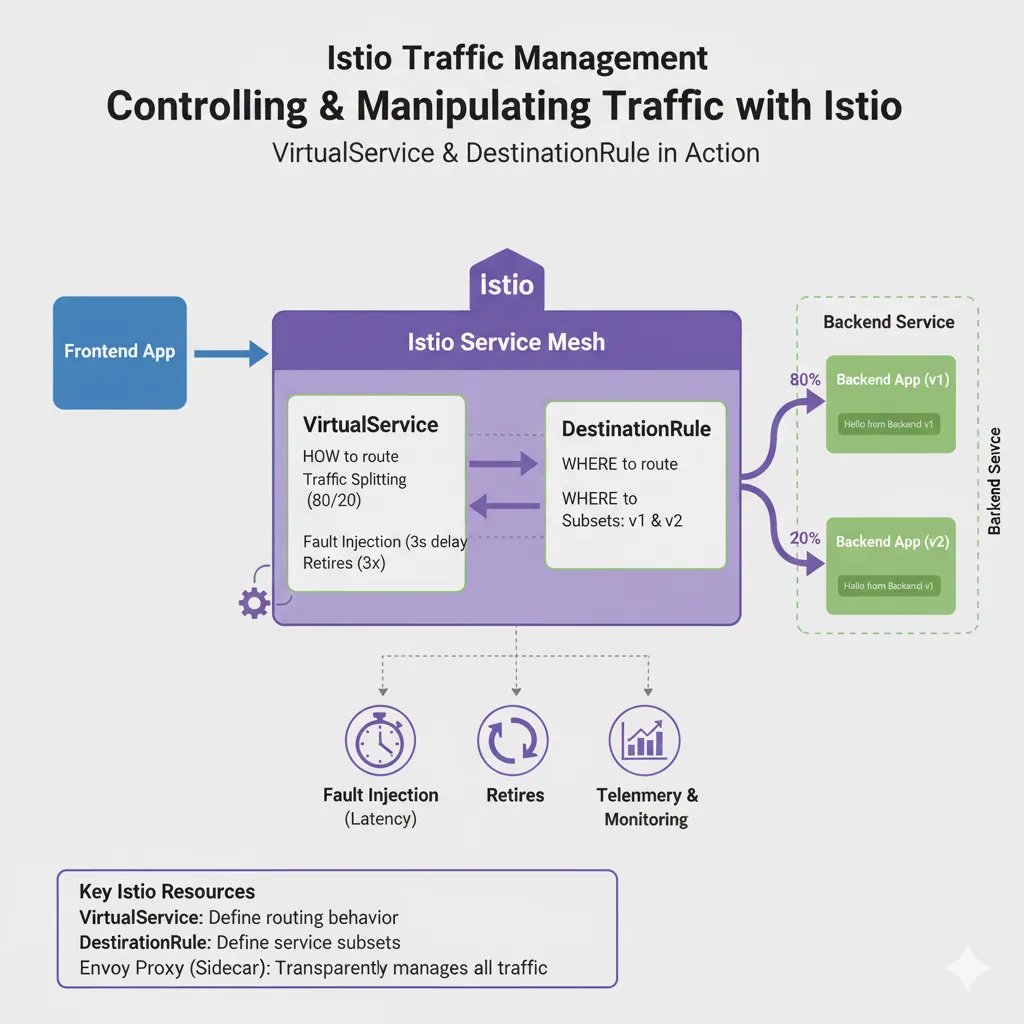⬅ Back to Intro | Next → Part 5 - Observability with Prometheus, Grafana, and Kiali
💡 This post is part of my Istio Hands-on Series — a practical journey into Kubernetes Service Mesh. Each post builds on the previous one with hands-on labs, real command outputs, and clear explanations aimed at learning Istio by doing, not just reading.
Objective
In this post, we’ll learn how to use Istio’s traffic management features — specifically:
VirtualService(to define how traffic is routed)DestinationRule(to define where traffic is routed)
By the end, you’ll:
- Deploy two versions of your backend service
- Split traffic between them
- Perform canary-style rollouts
- Simulate faults and retries
Step 1: Recap – Your Current Setup
You should already have:
- A frontend deployment that sends requests to
backend - Istio sidecar injection enabled
frontend → backendcommunication working
We’ll extend that setup to include a second backend version (v2).
Step 2: Deploy Backend v1 and v2
Let’s modify the existing backend deployment to include two versions.
cat <<EOF | kubectl apply -f -
apiVersion: apps/v1
kind: Deployment
metadata:
name: backend-v1
spec:
replicas: 1
selector:
matchLabels:
app: backend
version: v1
template:
metadata:
labels:
app: backend
version: v1
spec:
containers:
- name: backend
image: hashicorp/http-echo
args: ["-text=Hello from Backend v1"]
ports:
- containerPort: 5678
---
apiVersion: apps/v1
kind: Deployment
metadata:
name: backend-v2
spec:
replicas: 1
selector:
matchLabels:
app: backend
version: v2
template:
metadata:
labels:
app: backend
version: v2
spec:
containers:
- name: backend
image: hashicorp/http-echo
args: ["-text=Hello from Backend v2"]
ports:
- containerPort: 5678
---
apiVersion: v1
kind: Service
metadata:
name: backend
spec:
selector:
app: backend
ports:
- port: 80
targetPort: 5678
EOF
Verify:
kubectl get pods -l app=backend
✅ You should see both versions running:
backend-v1-xxxxx 2/2 Running
backend-v2-xxxxx 2/2 Running
Step 3: Add a DestinationRule
A DestinationRule defines subsets — logical groups of service versions (based on labels) that you can route traffic to.
cat <<EOF | kubectl apply -f -
apiVersion: networking.istio.io/v1alpha3
kind: DestinationRule
metadata:
name: backend
spec:
host: backend
subsets:
- name: v1
labels:
version: v1
- name: v2
labels:
version: v2
EOF
Check:
kubectl get destinationrule
✅ Output:
NAME HOST AGE
backend backend 9s
Step 4: Create a VirtualService
Now, let’s control how requests are routed between v1 and v2.
We’ll start with 100% traffic to v1 .
cat <<EOF | kubectl apply -f -
apiVersion: networking.istio.io/v1alpha3
kind: VirtualService
metadata:
name: backend
spec:
hosts:
- backend
http:
- route:
- destination:
host: backend
subset: v1
weight: 100
- destination:
host: backend
subset: v2
weight: 0
EOF
Step 5: Test Traffic Routing
Run:
kubectl exec deploy/frontend -- curl -s http://backend
✅ You should see:
Hello from Backend v1
Now let’s gradually shift some traffic to v2.
Step 6: Split Traffic 80/20 Between v1 and v2
Update your VirtualService:
cat <<EOF | kubectl apply -f -
apiVersion: networking.istio.io/v1alpha3
kind: VirtualService
metadata:
name: backend
spec:
hosts:
- backend
http:
- route:
- destination:
host: backend
subset: v1
weight: 80
- destination:
host: backend
subset: v2
weight: 20
EOF
Run several requests:
for i in {1..10}; do kubectl exec deploy/frontend -- curl -s http://backend; done
✅ Output (mixed):
Hello from Backend v2
Hello from Backend v2
Hello from Backend v1
Hello from Backend v1
Hello from Backend v1
...
Congratulations 🎉 — you’ve just performed a canary release in Istio!
Step 7: Fault Injection (Simulating Latency)
Let’s simulate a slow backend to see how Istio handles delays.
cat <<EOF | kubectl apply -f -
apiVersion: networking.istio.io/v1alpha3
kind: VirtualService
metadata:
name: backend
spec:
hosts:
- backend
http:
- fault:
delay:
percentage:
value: 50
fixedDelay: 3s
route:
- destination:
host: backend
subset: v1
weight: 100
EOF
Now test again:
for i in {1..5}; do kubectl exec deploy/frontend -- time curl -s http://backend; done
✅ You’ll notice roughly half the requests are delayed by ~3 seconds.
Hello from Backend v1
real 0m 3.01s
user 0m 0.00s
sys 0m 0.00s
Hello from Backend v1
real 0m 0.01s
user 0m 0.00s
sys 0m 0.00s
Hello from Backend v1
real 0m 0.00s
user 0m 0.00s
sys 0m 0.00s
Hello from Backend v1
real 0m 3.02s
user 0m 0.00s
sys 0m 0.00s
Hello from Backend v1
real 0m 0.01s
user 0m 0.00s
sys 0m 0.00s
Remove the fault rule:
kubectl delete virtualservice backend
Step 8: Add Retry Logic
Let’s add a retry policy so the frontend automatically retries failed calls.
cat <<EOF | kubectl apply -f -
apiVersion: networking.istio.io/v1alpha3
kind: VirtualService
metadata:
name: backend
spec:
hosts:
- backend
http:
- retries:
attempts: 3
perTryTimeout: 2s
retryOn: gateway-error,connect-failure,refused-stream
route:
- destination:
host: backend
subset: v1
EOF
This tells Istio to retry up to 3 times if a connection fails.
Step 9: Summary
You just learned how to control and manipulate traffic using Istio’s most powerful features:
| Feature | Resource | Description |
|---|---|---|
| Traffic splitting | VirtualService + DestinationRule | Gradually route traffic between versions |
| Fault injection | VirtualService | Test failures or latency |
| Retries | VirtualService | Improve reliability on transient failures |
You now have fine-grained control over how traffic flows between services — without changing any application code.
🧵 Next Up
👉 Istio Hands-on Part 5 – Observability with Prometheus, Grafana, and Kiali
We’ll explore metrics, traces, and service graphs to understand what’s happening inside your mesh.
⬅ Back to Intro | Next → Part 5 - Observability with Prometheus, Grafana, and Kiali

Comments